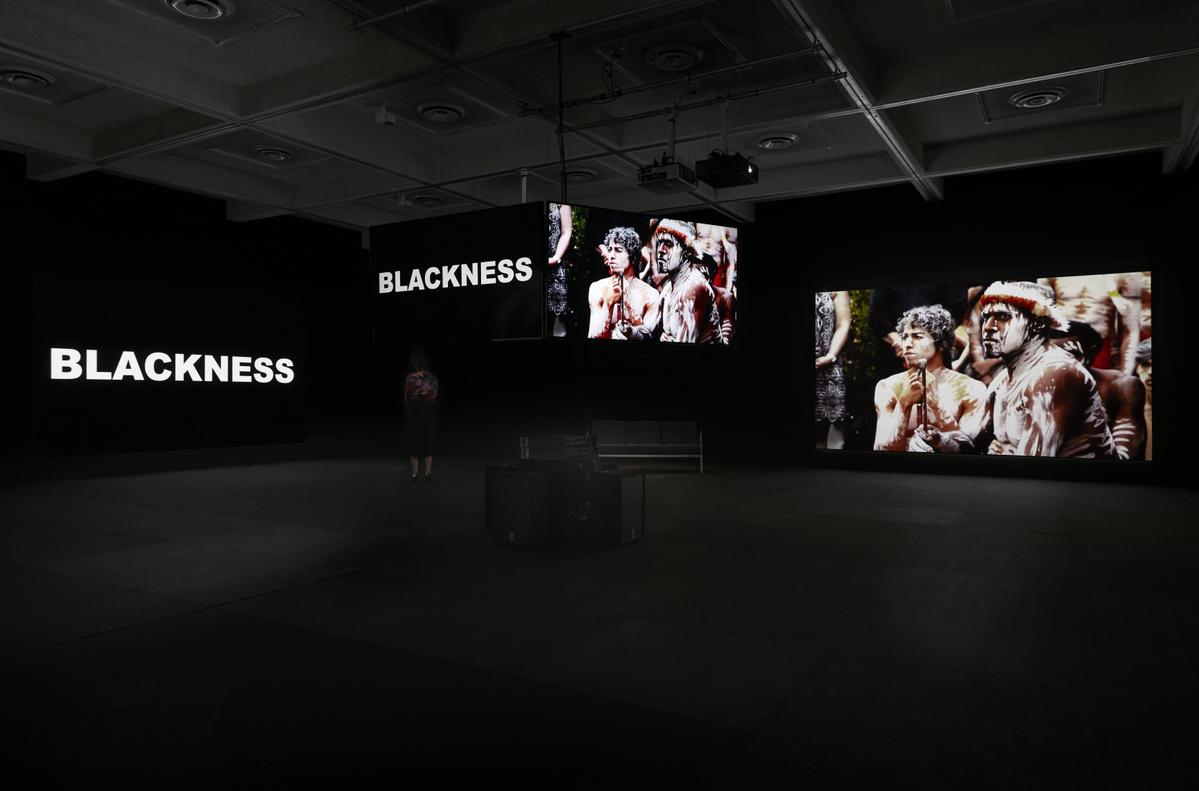"Yes I cried through my lens…I am still not done yet."
These words appear in the multi-screen work Ngiyaningy Maran Yaliwaunga Ngaara-li (Our Ancestors Are Always Watching) (2020) and quote its maker, the Gomeroi Murri Yinah photographer Barbara McGrady. It’s installed at the Campbelltown Arts Centre as part of the Sydney Biennale. Cinematic like a sports stadium, it’s a slideshow of her expansive archive documenting First Nations experience in Australia. The photographs and words switch to the beat of music, the bass reverberating through your limbs. At the Gallery of New South Wales, her work takes the form of huge prints which line the walls of the lobby. They’re mirrored by images by Musa N. Nxumalo, similarly celebratory and activist, this time from the streets and clubs of Soweto.
The Sydney Biennale is titled NIRIN, a Wiradjuri word meaning "edge." It is also the language of Brooke Andrew’s mother’s people. He is the first artist and First-Nations Australian to be appointed as Artistic Director—for the third oldest biennial in the world. NIRIN relocates its centre to the so-called peripheries, showcasing the work of indigenous and marginalised perspectives. It proposes "a place from which to see the world through different eyes," uniting 100 artists from 36 countries across six venues. These stretch from Cockatoo Island, a penal establishment turned arts venue in Sydney Harbour, to the Campbelltown Arts Centre, which is about an hours train from the city-centre. In between are the Museum of Contemporary Art, the Art Gallery of New South Wales, the National Art School and Artspace.
It helps to understand Andrew’s own practice, characterised by a potent use of archive, juxtaposition and an unnerving glamour. It scrutinises Australia’s amnesiac colonial history, reflected here through the framework of the "Biennale"(1) itself. Across the venues are clear traces of the artists hand. Powerful Objects is a series of displays of historical curio from the country’s national collections, dispersed across the venues. 15 Screens are similarly scattered TV installations screening artist video-work, documentary footage, infomercials and music videos. It’s long, and not supposed to be viewed in one sitting. Their sources range from Cambodia, to the Siksika Nation, to up-state—specifically Collarenebri Central School’s "Colli Crew", a group who rap about the struggle for rights and equality among First Nation Australians.(2)
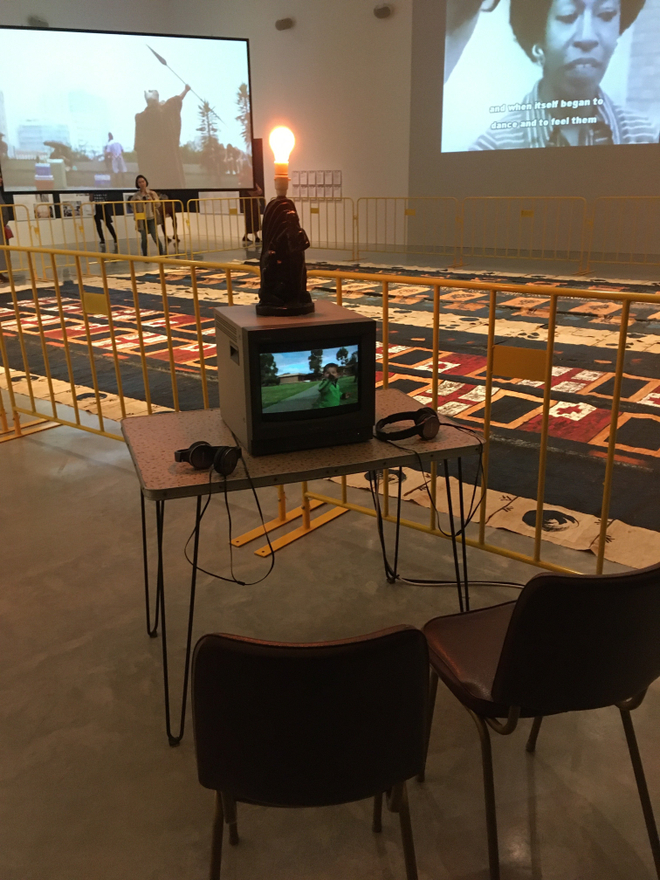
Installation view of 15 Screens (2020) Brooke Andrew, 22nd Sydney Biennale of Sydney. Photo by Moya Lawson
Both carry a curiously museological ethos, intervening in the otherwise "contemporary" spaces. These screens, which pop up everywhere, become a touchstone for much of the moving-image work on display. As a discordant kind of resource, it complicates notions of testimony (and the parts that video can play) by butting it up against a multitude of others.
White words on blue banners drape the neo-classical facade of the Gallery of New South Wales, by Mapuche Chilean poet Elicura Chihuailaf Nahuelpán. The pillars form ellipses between inviting, floating words: "My dream has turned into…the energy that lives and opens…the doors of my soul…its air became these words…the blue held by its song." The majority of the work inside occupies the already dense Grand Courts which house the European and Settler art collections. Their salon-hangs and marble plinths are interrupted by the Biennale artists. Paintings replace other paintings—including a blazing new body of work by Emily Karaka—and sculptures and installations intrude on auras—including huge, hanging black sheets by Joël Andrianomearisoa.
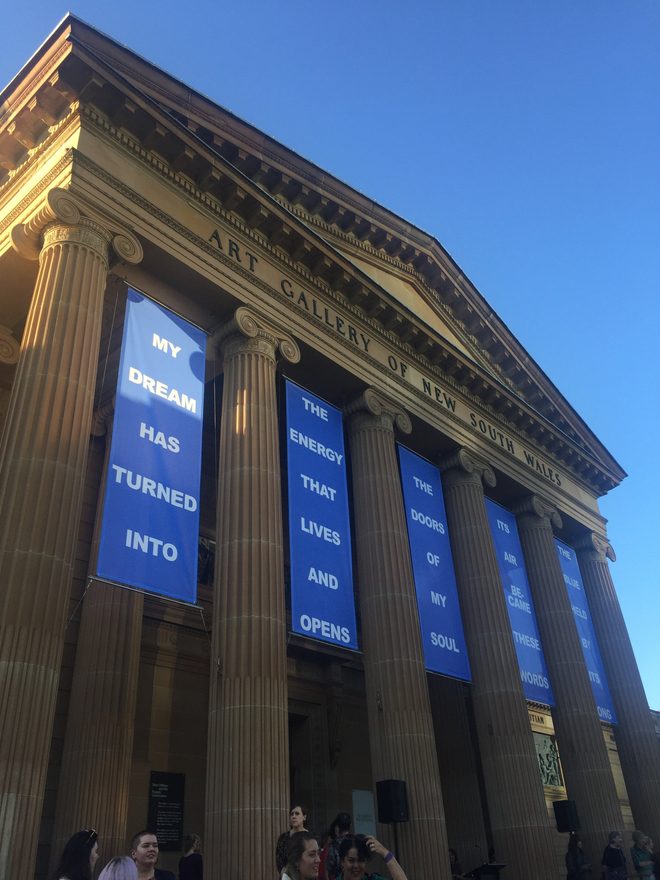
Installation view of Elicura Chihuailaf Nahuelpán, Machiluwvn / Iniciación / Initiation (2020). Photographed at the Art Gallery of New South Wales, 22nd Sydney Biennale of Sydney. Photo by Kauri Hawkins
Two video works by Nicholas Galanin are suspended in the far left and right cavities. Of Tlingit and Unangax̂ decent, his practice synthesises contemporary conditions with a strong connection to land and culture. The works present two interpretations of traditional Tlingit music, performed by different dancers. In one a hip hop dancer moves intuitively to a traditional piece, in the other a traditional dancer is set to an electro-dub remix made by Galanin.(3) Their sounds pulsate through the otherwise quiet, echoey rooms, imbuing its wandering people and cavalry charges with a strange immediacy.
Likewise, Arthur Jafa’s epochal film The White Album (2018-19) commands its space, neutralising the surrounding drama of Neo-Raphaelite and Orientalist painting. It’s a video-collage of found and created content, proposing a portrait of "whiteness" in America. Each label quotes their artist, and Jafa describes the work as reconciling the tension between "what one cannot know as a black person in America" and "my deep affection… for people in my life who would be termed ‘white’." Clips, recognisable and obscure, switch: a sports-fan dances to Livin’ On a Prayer; an ex-Neo-Nazi denounces white supremacy; a man demonstrates how many automatic guns he can hide on his person. The viewer may feel exposed, or even implicated. A blonde YouTuber confesses her irritation of the term "white people" while the image cuts, intermittently, to a white and black hand clasped lovingly in a woman’s lap. The latter delves deeper between her thighs. ‘" don’t wanna go on a huge thing about how life isn’t fair but, it’s just not…"
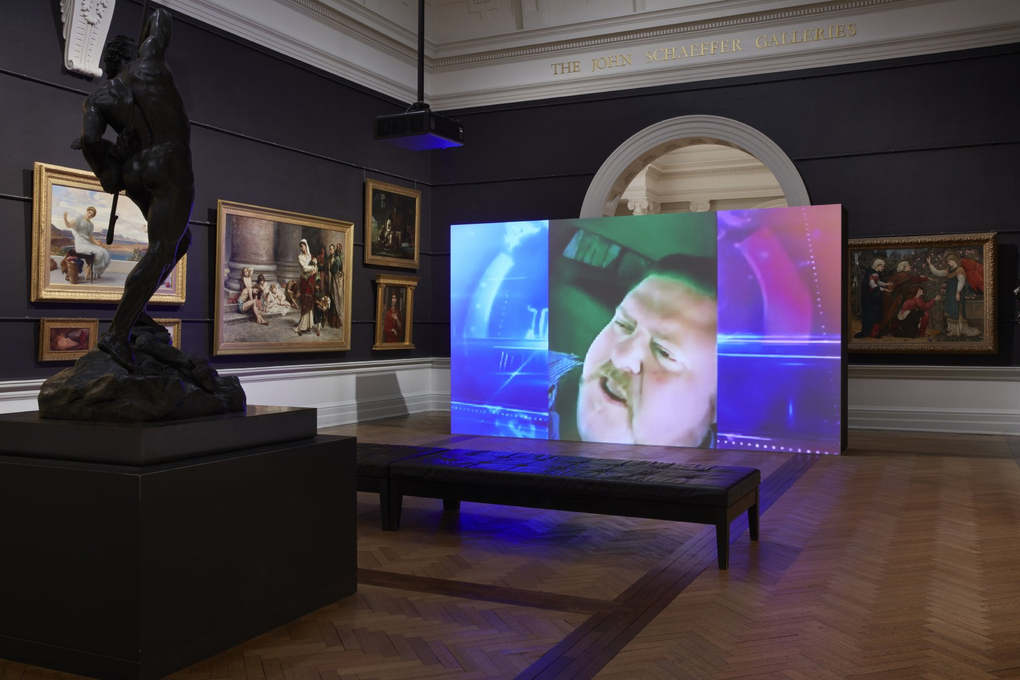
Installation view of The White Album (2018-19) (2020) Arthur Jafa. Photographed in the Grand Courts at the Art Gallery of New South Wales, Sydney. 22nd Sydney Biennale of Sydney. Photo by Zan Wimberley
Each work has been presented carefully and ambitiously. This is apparent in approaches to the video-screen, a single format that must deliver views from other worlds. At the MCA, a triangular formation presents three separate film works by Erkan Özgen. They document stories emerging from the Middle East's horrible, transmogrifying conflicts. In Wonderland (2016) 13-year-old Muhammed recounts his escape from Syria, and he is deaf and mute. Well over life-size, his gestures and exclamations illustrate a vivid and violent experience to the cocooned art-viewer.(4) Upstairs—to the side of a corridor darkened by Andrianomearisoa—Bow Echo (2020) by Aziz Hazara assumes five hovering screens that wrap the viewer. Five boys stand on the same knoll above a bleached desert city. They blow tirelessly into a toy bugle as they wobble and slip in the roaring wind. The work mourns for Khabul, Hazara’s home below, which has been decimated by a neverending, blinded violence. Both Hazara and Özgen reserve focus for the individual, as opposed to the spectacle of war. The physical presence of each work, engulfing and involving the viewer, empowers this intention.
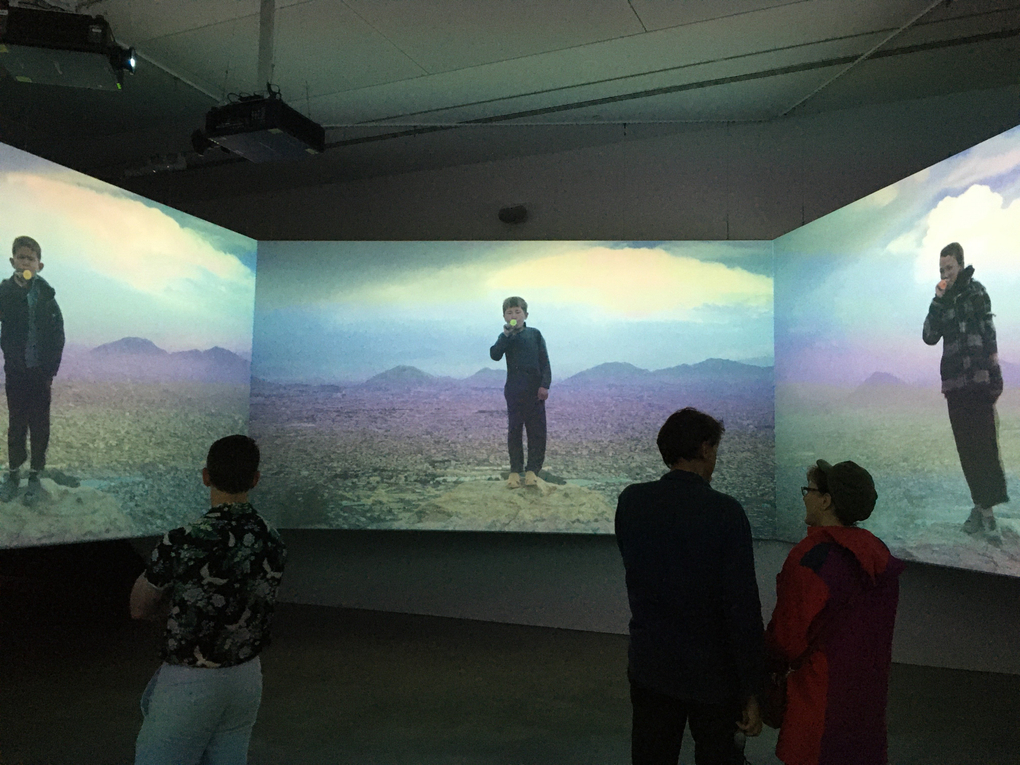
Installation view of Bow Echo (2020) Aziz Hazara, 22nd Biennale of Sydney. Photo by Moya Lawson
Film has also been included as a living context. Accompanying the stark photography of Zanele Muholi at the MCA, there is an (unexpected) screening of their film Ayanda & Nhlanhla Moremi’s wedding (2014). It is beautiful and infectiously ecstatic, documenting a civil union south of Johannesburg.(5) At one point in the street procession you see Muholi peering into the camera’s viewfinder, reflected in the car-window of the beaming bride. It’s a rare view of the artist, known for their piercing stare down the lens. They deliver a speech to the wedding party at the end, congratulating the couple for persevering in the name of love against the odds of unspeakable persecution. It’s inclusion deepens Muholi’s role as a ‘visual activist’, invested in the well-being of their subjects.
Cockatoo Island is a picturesque boat ride from the Opera House. It’s been a part of the Biennale since 2008. It’s a scarred, eerie place. Thirty-six artist projects are spread across several kilometres of early-settler ruins, ship-building warehouses and two subterranean tunnels. Known as "Wareamah" in the Darug language, it’s believed that before Europeans it was preserved as a place for women to carry out ceremonies. A colony of permanent tents are pitched at the waters edge, for the eccentric glamper. They embody a bitter irony given that the Aboriginal Tent Embassy claimed (and were denied) sovereignty over the abandoned island in the early 2000’s.
Inherently, this iteration activates and consoles this history. Several projects connect with it directly; including Healing Land, Remembering Country (2020), a community-built plant nursery at the centre of the convict precinct, facilitated by Tony Albert; and Ibrahim Mahama’s stunning installation No Friend but the Mountains (2012-2020), which dresses an entire interior of the Turbine Hall with jute sacks collected from Ghana’s export industries, calling up the island’s lost histories of indenture and labour.(6)
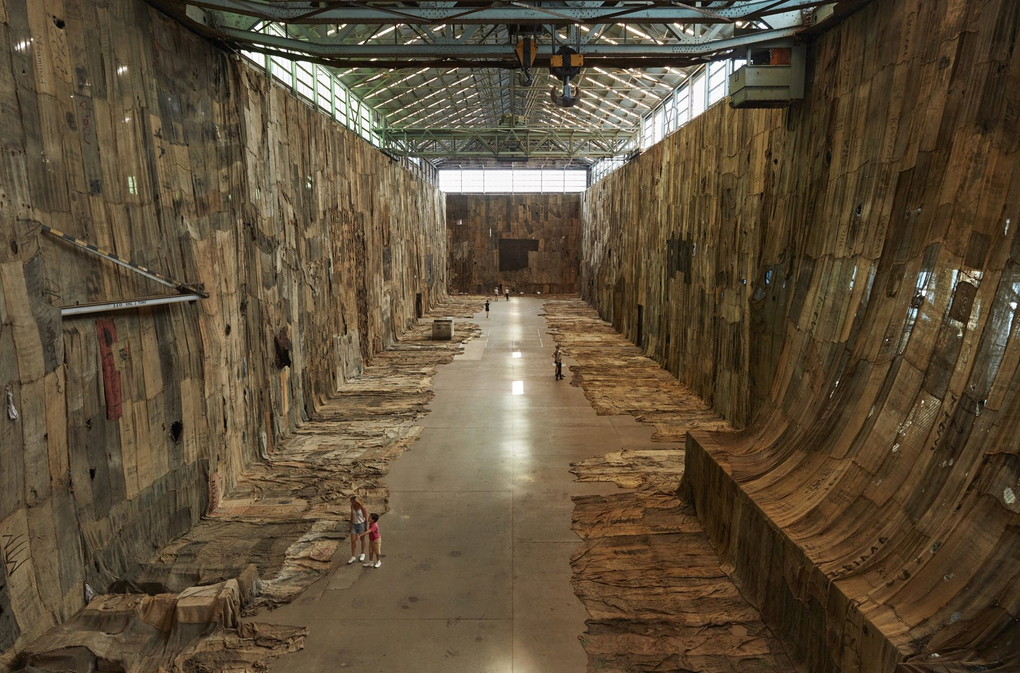
Installation view of No Friend but the Mountains 2012—20 (2020) Ibrahim Mahama, charcoal jute sacks, sacks, metal tags and scrap metal tarpaulin, dimensions variable. Installation view (2020) for the 22nd Sydney Biennale of Sydney, Cockatoo Island. Courtesy the artist, White Cube and Apalazzo Gallery, Brescia. Photograph Zan Wimberley
At an exit from Mahama’s installation, a gutted desktop screen sits on the floor. It’s been painted over with a message: "We are really re enactments of BC ancestral beings we are the living history." In a chamber beyond, an array of pimped arcade and pokie machines are circled by decorated and smashed plasma screens. Some hang like carcasses from rusty old hooks. Tennant Creek Brio is a collective of eight artists based in a Northern Territory frontier town, established with the Aboriginal Health Board to support men tackling substance abuse. As art therapy which is both destructive and regenerative, their work embodies a fiery social commentary. Psychedelic moving images and sounds occupy the machines. In their second installation at Artspace, a machine presents a behind-the-scenes film visualising their processes and collaboration.(7) Each screen is like an obliterated portal, rejecting a regime which has ostracised and disempowered them.
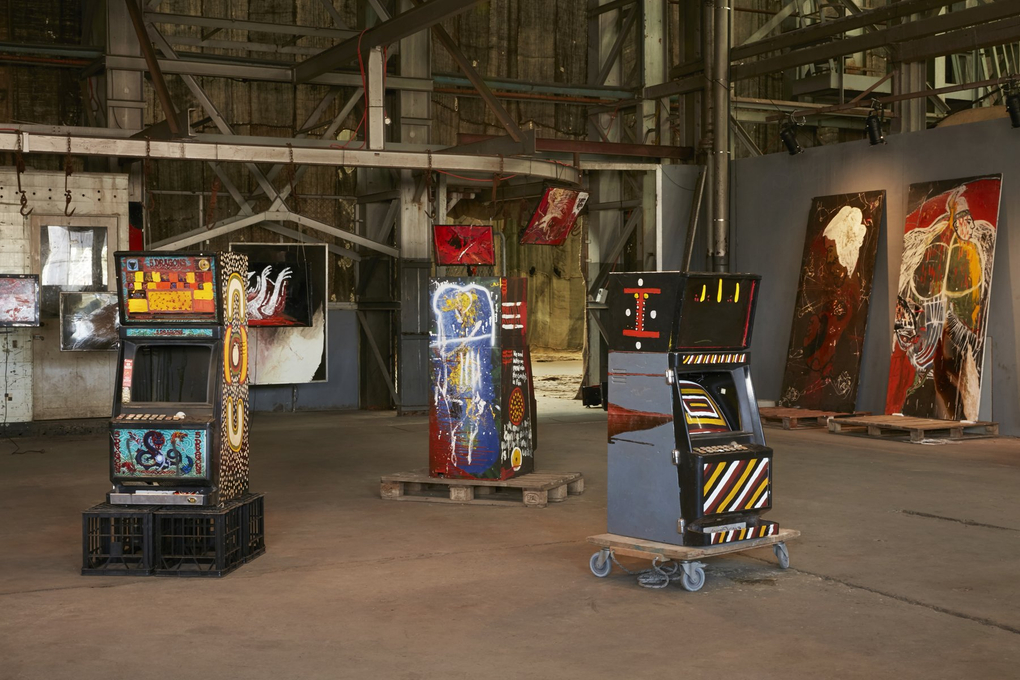
Installation view of Tennant Creek Brio, for the 22nd Sydney Biennale of Sydney, Cockatoo Island. Courtesy the artists and Nyinkka Nyunyu Art and Culture Centre. Photograph Zan Wimberley
References to individual experience, ancestral connection and deep time collide. In proximity, they pave ways to situate oneself in this world. At the National Art School, two immersive installations reflect this seesaw of micro and macro. Upstairs, Approximation to the Scenes of the Facts (2020), by Teresa Margolles, presents a profoundly moving eulogy for murdered women in Sydney. Red butchers curtains enclose a line of twenty heated iron plates which represent twenty crime-scenes across the city. They receive droplets of water, sponged and collected at these sites, which evaporate as they hit their surface. Below, Owed to Diaspora(s) (2020) is a video installation by Hannah Catherine Jones, who is also a trained musician. Overlaid with a hypnotic soundscape, which she would ideally perform, the work soothingly combines space and terrestrial entities (sun, moon, sand, water, smoke) with found video of figures who popularly represent the African diaspora—including a dancing, pregnant Beyoncé. It’s a time-slowing experience, empowering images besieged by pop culture. It aims to reconcile individual experience with universalising forms of connection, such as diaspora.(8)
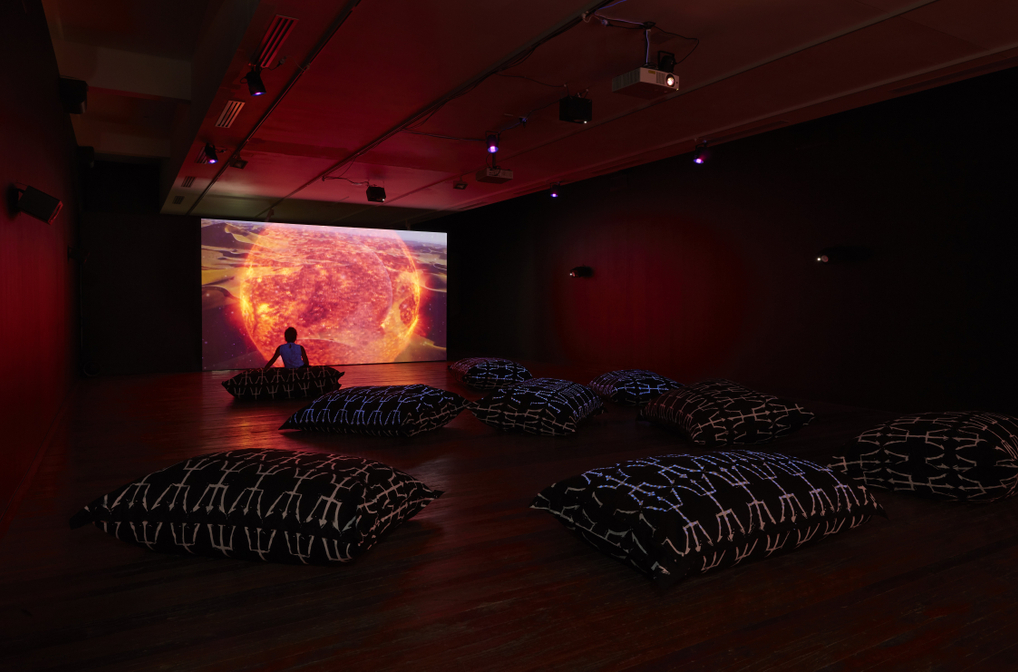
Installation view of Owed to Diaspora(s) (2020) Hannah Catherine Jones mixed media installation, dimensions variable, for the 22nd Sydney Biennale of Sydney, National Art School. Courtesy the artist. Photo: Zan Wimberley
This Biennale is bustling, crowded even. Bodies, images and sounds jar and interact in closely-knit constellations. This proposes a dynamic connectivity while baring each artworks singular power. Each part intervenes in the architectures and conventions of their venues, illuminating their imperialisms like a skeleton through skin. Working within an exhibition framework which is constantly inviting "re-invention", NIRIN is decisive. It conveys the importance of understanding the decolonisation project today—as a lived and unbroken cacophony of voices.
Less than a week after the Sydney Biennale opened to the public, Australia’s government announced the closure of its' borders. Covid-19 has charged these "different eyes" with an unprecedented context, and the biennial’s collapse of time zones seems even more surreal. Humanity is intimately, catastrophically connected as we have never experienced it before. We’ve been forced to redefine our bearings, from our fridge to our horizon, while we repel each other like magnets on our daily walks.
Our new reality is apparently eased by the Internet, but its potential has warped in the petrifaction of a pandemic. Artists the world over are having to cope with the assumption that they can convert their exhibition-making to an online platform. The Sydney Biennale has announced this move too, and its exciting that as an experience it will be (in some form) made available to a wider audience. But there’s a risk in pushing these demands too far, or of not recognising its limits and pitfalls. Fafswag, who were meant to take part in the Biennale this month, have tweeted a scathing view of the expectations that have now been placed on them.(9) However, they claimed, "if there’s any group that could achieve it, it’s us." Indeed, the individuals and communities in question have long managed to find belonging through the spaceless and connective realms that we now all depend on. And as McGrady claims, they will keep creating on their own terms.
p.s. The Biennale website has recently announced a rolling series of online programmes, from music to recipes to interviews, which virtual visitors can access from any desert island with a wifi signal. Keep an eye on it here!
